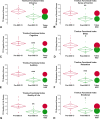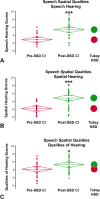Speech, Spatial, and Qualities of Hearing Scale and Tinnitus Functional Index Improvements After Cochlear Implant Surgery for Single-Sided Deafness
- PMID: 40264920
- PMCID: PMC12012636
- DOI: 10.1002/lio2.70090
Speech, Spatial, and Qualities of Hearing Scale and Tinnitus Functional Index Improvements After Cochlear Implant Surgery for Single-Sided Deafness
Abstract
Objective: Examine improvements in hearing and tinnitus-related quality-of-life metrics that occur after cochlear implant surgery in patients with single-sided deafness (SSD) and asymmetric hearing loss (AHL).
Methods: Adult patients undergoing cochlear implant surgery for SSD or AHL during a 2-year period at a quaternary academic medical center completed the validated survey instruments tinnitus functional index (TFI) and Speech, Spatial, and Qualities of Hearing Scale (SSQ) before surgery, and at least 3 months after cochlear implant activation. Standardized protocols for audiometric assessment were completed pre- and postoperatively.
Results: Twenty-four patients met inclusion criteria and had complete audiometric and survey data. Overall, composite TFI score improved significantly from a mean severity of 48.2 ± 9.2-18.6 ± 6.53; after cochlear implantation (q = 2.01, p < 0.001) and there was statistically significant improvement in all eight subdomains of the TFI after surgery. The SSQ composite scores significantly improved from a mean of 2.5 ± 0.30-5.07 ± 0.44 after CI (q = 2.01, p < 0.001). All three subdomains of the SSQ improved significantly after cochlear implantation though the magnitude of the changes were higher for Speech Hearing and Spatial Hearing compared with the Qualities of Hearing domain.
Conclusions: Cochlear implantation surgery in patients with SSD or AHL leads to significant overall improvements in hearing related quality of life, but particularly in the areas of speech understanding, spatial aspects of hearing, and tinnitus severity.
Level of evidence: 3.
Keywords: cochlear implant; quality of life; single‐sided deafness; spatial awareness; tinnitus.
© 2025 The Author(s). Laryngoscope Investigative Otolaryngology published by Wiley Periodicals LLC on behalf of The Triological Society.
Conflict of interest statement
The authors declare no conflicts of interest.
Figures



Similar articles
-
[Analysis of one-year outcomes after cochlear implantation in adults with single-sided deafness].Zhonghua Er Bi Yan Hou Tou Jing Wai Ke Za Zhi. 2024 Jun 7;59(6):602-613. doi: 10.3760/cma.j.cn115330-20231113-00202. Zhonghua Er Bi Yan Hou Tou Jing Wai Ke Za Zhi. 2024. PMID: 38965850 Chinese.
-
The impact of cochlear implantation on quality of life and psychological status in single-sided deafness or asymmetric hearing loss with tinnitus and influencing factors of implantation intention: a preliminary study.Eur Arch Otorhinolaryngol. 2024 Jan;281(1):95-105. doi: 10.1007/s00405-023-08086-7. Epub 2023 Jun 28. Eur Arch Otorhinolaryngol. 2024. PMID: 37378727
-
(Even Off-Label) Cochlear Implantation in Single-Sided Deafness and Asymmetric Hearing Loss Results in Measurable Objective and Subjective Benefit.Otol Neurotol. 2022 Sep 1;43(8):e895-e902. doi: 10.1097/MAO.0000000000003623. Otol Neurotol. 2022. PMID: 35970168
-
Implantable Devices for Single-Sided Deafness and Conductive or Mixed Hearing Loss: A Health Technology Assessment.Ont Health Technol Assess Ser. 2020 Mar 6;20(1):1-165. eCollection 2020. Ont Health Technol Assess Ser. 2020. PMID: 32194878 Free PMC article.
-
Cochlear Implantation in Children With Single-Sided Deafness: A Systematic Review and Meta-analysis.JAMA Otolaryngol Head Neck Surg. 2021 Jan 1;147(1):58-69. doi: 10.1001/jamaoto.2020.3852. JAMA Otolaryngol Head Neck Surg. 2021. PMID: 33151295 Free PMC article.
References
-
- Shapiro S. B., Llerena P. A., Mowery T. M., Miele E. A., and Wackym P. A., “Subtemporalis Muscle Middle Cranial fossa Bone Island Craniotomy Technique for Placement of an Active Transcutaneous Bone‐Conduction Implant,” Otology & Neurotology 44, no. 1 (2023): 54–60, 10.1097/MAO.0000000000003760. - DOI - PMC - PubMed
LinkOut - more resources
Full Text Sources
Research Materials
Miscellaneous
